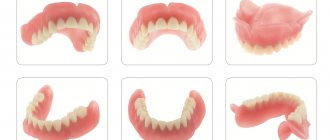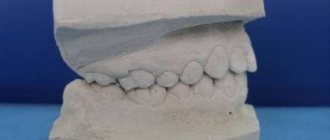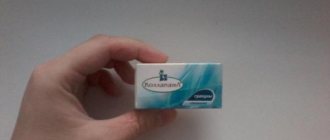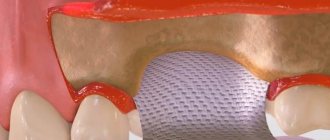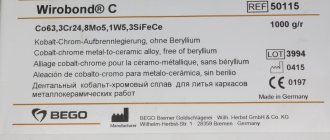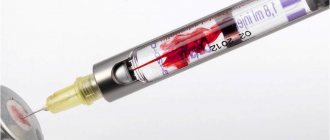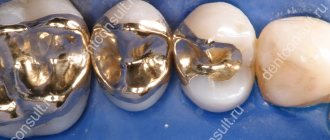1856
Technologists have thoroughly studied the physical properties of medical plastics, which has made it possible to widely introduce fast-hardening material into the practice of dentistry, orthodontics and maxillofacial surgery.
Orthodontic appliances are designed to correct abnormalities of the jaw system. However, the design of the devices will not function properly without fast-hardening materials.
In addition, acrylic substances are used to make dental crowns used in prosthetics.
General overview
Rapid-hardening plastics are also called self-hardening. In medical practice, the adaptation of this type of material has technologically changed the process of creating structures.
Peculiarities:
- the ability of the material to undergo accelerated polymerization at everyday room temperature, or human body temperature;
- high level of compatibility of the material with other forms of substances;
- there is no destructive effect of the material on the oral mucosa.
In addition, medical compounds are used to repair damaged prosthesis bases.
Also, materials of this type make it possible to restore a combined non-removable structure directly in the oral cavity .
Composition and properties
Quick-hardening plastic masses are used in orthodontics in various variations, most often in the manufacture of removable and non-removable appliances and their parts.
Each factory package contains a powdery substance (varieties of acrylic), liquid (methyl methacrylate with various additives) and activators.
When these three components are combined, a solid dental material for prosthetics is formed, and polymerization occurs.
Functional features of the constituent elements:
- Powder is an ether polymer of methacrylic and acrylic acids with various metal additives. This substance also contains dyes and plasticizers. The powdery substance is the basis for creating materials.
- The liquid consists of ether compounds of methacrylic acid, chemical compounds similar in composition - monomers and various additives.
- Monomer is an ethereal transparent consistency with a strong characteristic odor.
Improper storage can cause self-polymerization, so it is important to tightly seal the bottle and add an inhibitor to prevent the substance from hardening. The function of this substance is to polymerize the composition without heating. - Fillers are able to add viscosity to the powder, increase the strength of the composition and protect polymers from rapid wear. In addition, there are antimicrobial fillers that prevent the formation of microorganisms in polymers.
High quality medical plastics must be packaged in kits containing liquid and powder.
What design of a removable denture for the upper jaw do dentists consider the best?
Come here if you are interested in the reasons for the development of denture stomatitis.
At this address https://www.vash-dentist.ru/protezirovanie/semnyie-p/vidov-pri-otsutstvii-bolshogo-kolichestva-zubov.html we will consider the types of prosthetics in the absence of a large number of teeth.
Self-hardening plastics. This group includes plastics that can polymerize without external heating. Acrylic plastics acquire this property if an activator is introduced into their composition, capable of breaking down benzene peroxide into radicals at a low ambient temperature (room or oral temperature).The use of self-hardening plastics in dentistry has made it possible to expand the scope of use of plastics. Based on them, new filling materials have been proposed; they have simplified a number of dental and medical procedures when correcting and repairing dentures, and have made it possible to simultaneously manufacture some dentures, splints, and devices. Currently, the domestic industry produces a wide variety of self-hardening plastics, among which the most popular are pro-tacryl, redont, noracryl, stadont, and carboplast. Protacryl (powder) consists of finely divided pink polymethyl methacrylate, 1.5% benzoyl peroxide and 2% disulfan amine. The liquid is methyl methacrylate with demethylparatoluidine introduced into it (0.1-0.2%). Disulfanamine and dimethylparatoluidine are activators. Protacryl is used in orthopedic dentistry both in clinics and in dental laboratories. Some temporary splints and devices are made from it, and it is used to correct and repair removable dentures. Plastic dough is prepared by mixing powder and liquid in a 2:1 ratio. Upon reaching the viscous stage, the mass can be molded into a ditch, and when repairing or correcting prostheses, it can be applied to cleaned surfaces. Polymerization of the plastic dough occurs after 15-20 minutes. The process can be accelerated by heating to 40-45°C. When correcting or repairing dentures made from acrylic polymers, protacryl, due to chemical affinity, forms a monolithic connection with the denture material. Plas has physical and chemical properties close to base materials. Pedont is a self-hardening plastic, a copolymer of methyl and ethyl esters of methacrylic acid, produced industrially in the form of a preparation consisting of powder and liquid. The powder is a copolymer of methyl methacrylate and ethyl methacrylate in a ratio of 9:1, contains benzoyl peroxide, dye and opacifier. The liquid is methyl methacrylate, to which dimethyl paratoluidine (activator) and hydroquinone (inhibitor) have been added. The drug "Redont" is used in clinical and laboratory practice for the correction and repair of dentures and devices made from acrylic plastics by cold curing. Along with this, redont is successfully used for the manufacture of orthopedic devices with the polymerization of plastic in a humid environment under low pressure of 1.5-2 atm in a special vessel such as a pressure cooker. In this case, the plastic becomes stronger, with fewer pores and at the same time more elastic; polymerization time is much shorter and no packing into a cuvette is required.
Stadont is a self-hardening plastic, similar in composition to redont. Has increased adhesion to hard dental tissues. Powder is a copolymer of methyl and ethyl esters of methacrylic acid, in a ratio of 98:2, benzoyl peroxide (initiator), dyes, opacifier. The liquid is methyl methacrylate, dimethyl paratoluidine (activator) and hydroquinone (inhibitor). Powders of three colors: No. 0 (colorless), No. 16 and No. 19. Stadont is used to make temporary dental splints in the treatment of periodontal disease and sometimes jaw fractures.
Self-hardening plastics Self-hardening plastics part 2
| Next > |
Next articles:
- Minerals for porcelain production
- Dental porcelain
- Ceramic materials
- Artificial teeth made of plastic
- Self-hardening plastics part 2
Previous articles:
- Plastics for fixed dentures
- Elastic plastics
- Basic plastics
- Preparation of acrylic powder
- Methods for producing plastics
Next page >>
111
Advantages and disadvantages
The materials are used in medicine for various purposes. Versatility is associated with a set of good basic physical and chemical properties.
The advantages of the material in orthodontics are undeniable:
- do not have harmful effects on the body;
- the material is highly durable and can withstand strong mechanical stress;
- the ability to eliminate the breakdown of a fixed prosthesis directly in the oral cavity;
- the ability of the material to quickly self-polish (harden) under normal conditions, which simplifies the process of filling teeth;
- has a color similar to the natural color of the dental crown;
- a fast, simplified material processing technique that reduces the time required for manipulations in the patient’s oral cavity.
However, there are also disadvantages:
- inexpensive types may have an unaesthetic appearance;
- may darken during prolonged use;
If the consistency is not prepared correctly, the material becomes insufficiently strong and is susceptible to chipping.
Popular products
Several basic types of plastics, which are universal, are widely used in dental practice.
The powdered composition should be mixed in certain proportions, and it can be used in different viscosity states.
Protacryl
The substance is classified as a basic type of self-hardening plastic. Supporting properties are distinguished:
- powder with a pink tint contains polymethyl methacrylates, initiators, activators, opacifiers, dyes;
- manufacturability and high strength;
- does not change color upon contact with oral tissues;
- used in the reconstruction of removable dentures;
- in case of loss of adhesiveness, it is used for restoration of bases.
In addition, the material is widely used for the manufacture of various orthodontic appliances.
Noracryl
This product is most often used in medical practice to restore damaged bridges.
Characteristics of Noracryl:
- contains three types of powders, two liquid catalysts and a liquid solvent, a filler that reduces water absorption;
- the resulting mass is used for filling dental canals and applied to the dental cavity;
- The curing time of the material is minimal and reaches 5-7 minutes.
The duration of mixing this type of material should not exceed one minute.
Carboplast
A polymeric substance with a yellow color. Characteristics of carboplast substance:
- the composition contains a ternary copolymer of methyl acrylate, butyl methacrylate, liquid, epoxy resin, stabilizer, filler - chalk;
- the material kneads well in the hands after mixing, this allows it to be evenly distributed over the plaster model;
- hardens at room temperature directly on the model.
Widely used when creating casts and models for further orthopedic work.
Redont
One of the forms produced for medical purposes in three main versions - opaque Redont, unpainted and transparent Redont-02, pink transparent Redont-03.
Characteristics:
- The product consists of powdered copolymer of methyl methacrylate and ethyl methacrylate, liquid methyl methacrylate, inhibitor, activator;
- used to restore broken dentures;
- used in the design of various medical mechanisms.
The main use of Redont is to move removable dentures in cases where the fit to the tissues of the oral cavity is disrupted or when there is a loss of adhesion to dental crowns.
Stadont
Acrylic substance having the following characteristics:
- main composition: methyl copolymer powder, opacifier and liquid methacrylic acid methyl ester, catalyst, stabilizer;
- factory markings contain substances of three different shades;
- are used in the production of medical fixing splints used in the presence of periodontal disease.
The main purpose of the product is to use it for the repair of bridge structures and removable plate prostheses.
Acrylic oxide
The product is white in color and has positive chemical characteristics:
- main composition - resins (acrylic and epoxy), mineral fillers;
- the product is not subject to shrinkage;
- has a color similar to the natural color of teeth;
- has high plasticity.
It is used for filling canals, making crowns, modeling dental inlays.
Carbondent
An acrylic substance having a composition with enhanced physical and chemical properties. Characteristics:
- the powder contains methyl acrylate ternary copolymer, butyl methacrylate, liquid with the addition of epoxy resin, mineral fillers, a stabilizer, a substance that protects the material from aging;
- The preparation kit contains 6 powders, differing in color type;
- improved characteristics of strength and adhesiveness.
A mass prepared from powder is used to create dental impressions.
Five popular models of containers for dentures and their features.
In this publication we will tell you what compensation pensioners are entitled to for dental prosthetics.
Here https://www.vash-dentist.ru/protezirovanie/semnyie-p/nedorogie-zubnyie-nadezhnyimi.html read about the types of inexpensive dentures.
Popular materials
Dentists use certain types of self-hardening plastics in their work. The choice of one material or another depends on the type of work to be done.
Protacryl
This plastic contains pink powder of three components: disulfinamine activator, benzoyl peroxide and fine polymethyl acrylate, and liquid - methyl methacrylate mixed with dimethylparatoluidine activator.
The curing speed of protacryl is very high - 15-20 minutes, it is durable and has good color fastness.
Its packaging usually contains: a bag of powder, a container of liquid, a bottle of release varnish, a bottle of dichloroethane (glue).
The area of application of protacryl is the repair and relining of bridge prostheses, the manufacture of structures used in orthodontics.
Noracryl
The components of the paste are a fine dispersion emulsion powder consisting of a sulfinic acid derivative and benzoyl peroxide and a monomer in the form of a clear liquid that has a specific odor and high volatility. You need to be able to work confidently and quickly with this paste, since its adhesion depends on the speed of its use. The newly mixed substance, placed in the cavity of the tooth, firmly adheres to its walls.
If noracryl begins to thicken earlier, the fixation strength becomes much lower.
The paste is used for filling teeth, making fixed dentures, finishing pins, repairing plate systems, and relining them.
Carboplast
This self-hardening plastic is based on acrylic. Carboplast contains epoxy resin, butyl methyl acrylate, and chalk as a filler. The material is highly plastic and can be easily applied to any plaster model. Area of use: production of individual impression trays.
Redont
The powder for producing a cold-hardening material contains an acrylate copolymer, benzoyl peroxide, and a coloring pigment. The polymerization liquid consists of methyl methacrylate, dimethyl paratoluidine, hydroquinone. The plastic mass obtained after polymerization has low porosity, elastic and durable. It is used to correct the fit of the prosthesis to the mucous membranes and surfaces of the teeth and in the manufacture of systems for correcting occlusion.
Stadont
The composition is identical to redont. The ratio for mixing powder and liquid to obtain a paste is 2:1. It is used to prepare splints to strengthen mobile teeth during the treatment of periodontal disease; it is used to repair fixed bridge prostheses and removable plate systems. The substance is available in a set of three 50 g packets of powder and a 120 ml bottle of liquid.
Acrylic oxide
The use of acrylic oxide allows one to obtain good ductility, the ability to polish, and no shrinkage during polymerization
This self-hardening material consists primarily of epoxy resins. Its advantages include: good ductility, the ability to polish it, no shrinkage during polymerization, high-quality color rendition.
Scope of application of acrylic oxide:
- Filling carious cavities
- Manufacturing of various onlays and crowns
- Repair of parts of removable dentures
You need to work with the material quickly, because it remains plastic for only 1-2 minutes. Acrylic oxide cures completely in less than 10 minutes.
Carbondent
This dental paste is based on active copolymers and the BIS-GMA monomer. It has low thermal expansion and water absorption, and is easy to process and polish in its finished form. Scope of application:
- Fillings for front teeth and molars
- Manufacturing of parts of fixed dentures
- Restoration of damaged removable dentures
- Installation of adhesive type bridge structures
Features of application
It is necessary to use products for medical purposes only if mixed in the correct proportions.
Features of the use of materials:
- The liquid is mixed with the powdered composition until a viscous substance is formed. Excess monomer can lead to increased material shrinkage, porosity and poor coloration.
The mixed composition is tightly closed. Over a half-hour period of time, the mass swells and goes through several stages: sandy, viscous, dough-like, rubbery. - The polymerization mode occurs when immersed in water or heated and the presence of an activator. The individual regimen must correspond to the description on the packaging.
It is important to follow the instructions exactly, because if the polymerization process is shortened, there will be an excess of monomer, which will provoke inflammatory processes in the mucous membrane. If overheated, it will become excessively brittle. - During the production of prostheses, the formation of porosity in the material is possible. This phenomenon occurs during accelerated polymerization and when there is a lack of monomer.
If the proportions are observed, the listed phenomena and deformation can be avoided. Depending on the stage of swelling, specialists use the material for filling, making devices, and making impressions.
The video discusses the properties of quick-hardening plastic for the manufacture of prostheses.
Heat resistance and thermal conductivity
Heat resistance is understood as the maximum operating temperature of a polymer at which the material can withstand a certain load for a given time, maintaining its geometric shape after cooling. Operating temperatures for the use of plastics, grinding and polishing must occur within the heat resistance range, otherwise mechanical changes will occur.
Thermal conductivity, or the ability to transfer heat, depends on the polymer matrix and filler. The indicator increases with increasing molecular weight. These two thermal characteristics affect the shrinkage of the material, the occurrence of defects in the production of prostheses, and comfort during use.
Various physical and chemical processes affect the aging process of polymers. Destruction in them occurs due to exposure to biological media, mechanical stress and strong temperature changes. Destruction causes fragility of dental dentures and loss of their functionality.
Reviews
Plastics have the ability to quickly harden under normal conditions, so they are widely used in medical practice for filling, manufacturing and repairing devices.
You can share your feedback on the use of plastics in the comments to this article.
If you find an error, please select a piece of text and press Ctrl+Enter.
Tags prosthetics removable dentures
Did you like the article? stay tuned
Previous article
Types of complications that arise after dental prosthetics and treatment tactics
Next article
What justifies the popularity of French TBR implants in many countries around the world?
